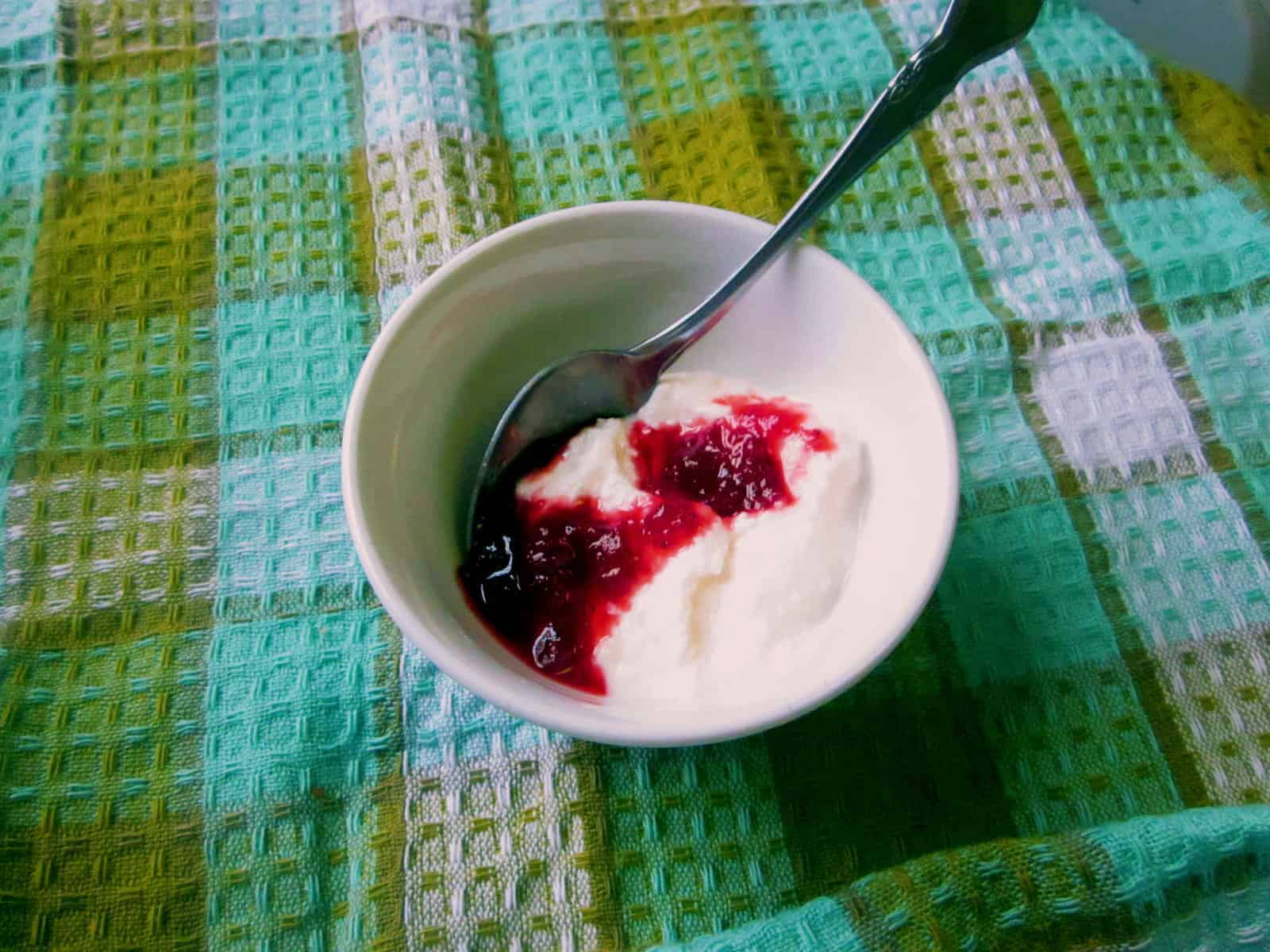
A rich homemade lactose-free yogurt means you get to enjoy real dairy yogurt without the pain of eating dairy - and all it takes is just one night of hands-off "work". Give it a try today!
I have moved countries four times in my life. I have changed homes many more times. In every newly inhabited space, the acclimatization process wasn’t easy; it took me time to get used to the new walls, the temperature, the people and, of course, the food.
On my family’s first night in Israel, I tasted a revelation. The texture, the coolness, the flavor and, of course, the slight hint of fruit in that plastic yogurt cup nearly blew my six-year-old mind. Now, before you click the exit button and get the hell out of dodge (“what kind of a food writer talks about yogurt as a revelation??”), hear me out. Until that point, I had never tasted yogurt.
Don’t get me wrong – I came to Israel fully acquainted with the tart, thirst-quenching taste of kefir, a cultured dairy drink favoured among many post-Soviet nations (I think the idea of pretty much letting milk go bad on the counter and then still drinking it was definitely the saviour of many a Soviet household during the food rationing days). Yet I was also deeply familiar with the nausea it would provoke in my small six-year-old stomach, a feeling that would arise just as soon as I smelled the vile concoction.
So as you can imagine, my parents really weren’t very hopeful upon that first night in a new country, following a harrowing 20-something-hour flight, with their sweating, scowling eldest daughter looking at them with eyes that practically spelled hunger, and nothing to offer her but yogurt, jello cups and fresh fruit (I was also not a big fan of jello cups). But they took the risk, and after sufficient complaining, I relented… and so began a decades-long affair with sour dairy.
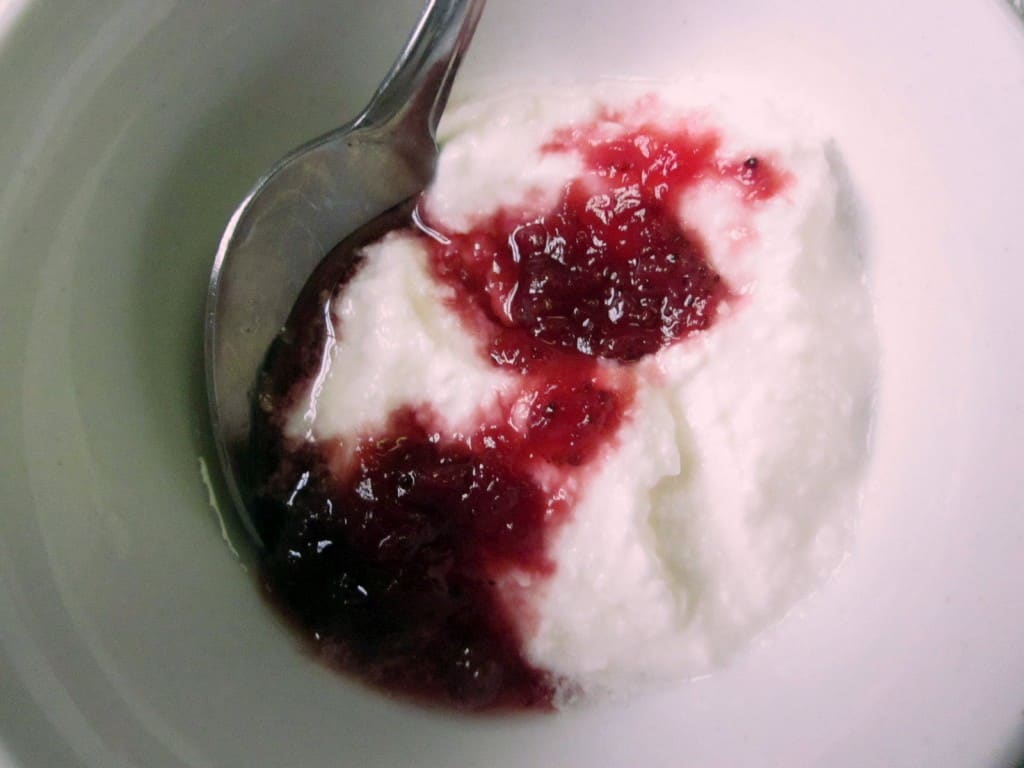
That is pretty much how I felt the same day I made my first lactose-free yogurt. You see, since I realized I couldn’t consume lactose anymore, what I missed the most wasn’t fresh milk, pungent cheese, or rich butter. I missed all those things, for sure, but what I dreamt about every afternoon was my customary cup of yogurt. No soy yogurt came even close to that mythical taste: fresh and cooling, with a sourness that can be easily tamed with just a dab of honey or jam. I just had to find a solution, or risk living life without yogurt.
And you wouldn’t want that, would you?
Next time, what do we do with all of that leftover whey?
Step-by-step lactose-free yogurt story!
See our step-by-step lactose-free yogurt story to find out how to make this delicious treat.
EDIT: This post has been featured on Punk Domestics! Support this great community by checking out more of their curated content.
Recipe
Tried and loved this recipe? Please leave a 5-star review below! Your reviews mean a lot to me, so if you've got any questions, please let me know in a comment.

Lactose-free yogurt
Ingredients
- 1 litre of lactose-free milk The percentage doesn’t really matter, though I go for 2 per cent. This is now fairly easily available in North America. In other countries, unfortunately, this ingredient presents more of a challenge
- 1 cup of pre-made yogurt with live cultures (most regular yogurt is fine, but aim for full fat and absolutely no flavoured stuff!)
- a big pot
- a big glass bowl or casserole dish with a lid
- a warm spot: on top of your fridge the inside of your turned-off oven with only the lamp on, or even a plastic cooler with blankets.
Instructions
- Fill a clean sink halfway with very cold water. Go on, you can even dunk some ice cubes in there.
- Take your cup of yogurt out of the fridge and let it rest at room temperature.
- Pour all of your milk into a big pot, and set it to medium-high. Cover the lid, and sit and watch the pot. They say a watched pot never boils, and you don’t want this thing to come to a full boil. After 5 minutes, test the milk by placing a very clean finger in the pot and then dabbing that drop on the outside of your other palm. When the milk feels hot and is very gently starting to bubble in the pot, take it off the stove (this could take anywhere between five and fifteen minutes).
- Alternative: you may also want to invest in a thermometer. The ready milk should measure about 160 degrees Fahrenheit.
- Take the lid off and place the pot in the half-full sink. Wait about 10 minutes before you start the same testing. This time, the milk should feel cool to touch.
- On a fancy thermometer, this would be about 100 degrees Farenheit.
- Now, pour your milk into the clean glass bowl. Dump a cup of room-temperature yogurt into your milk, and stir gently with a wooden spoon.
- Cover your bowl with a lid.
- Now, comes the fun part: place your glass bowl into a pre-determined warm place (on top of your fridge, the inside of your turned-off oven with only the lamp on, or wrapped in blankets inside a plastic cooler). I always go for the oven.
- Leave it alone overnight. Or, if it’s midday when you’re testing this (and it should never be midday. Yogurt-making is for lazy people who want time to do their work for them, and it goes best with a full night’s sleep), wait six to eight hours.
- Taste your yogurt. At this point, it’ll be sour and warm, and quite runny. It’ll harden in the fridge, after which you can ladle it into about 500ml pre-washed glass jars.
Notes
- For silky, creamy Greek yogurt, line a plastic colander with about four layers of cheesecloth large enough that the ends drape over the sides of the colander. After your yogurt has sat overnight in its warm nest, pour it carefully into the colander, and let it drain. If left at room temperature, about one hour should be enough (check for desired consistency). In the fridge, it can rest comfortably for two to four hours, but you may have to add some of the pooled whey back. And voila, you got some delicious Greek yogurt!

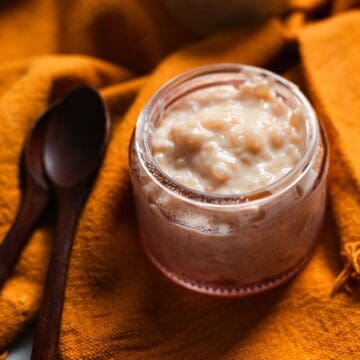

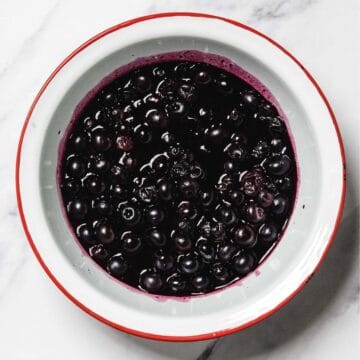

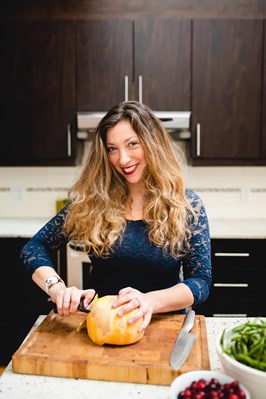
Jeanete says
Thank you for posting..I have been looking for this!!!
kseniaprints says
Yay! I'm glad I could help a fellow lactose-intolerant get their hands on quality yogurt 🙂
Anil says
I don't understand whether the starter yoghurt should be lactose-free yogurt also or whether it can be regular whole milk. Can you please clarify?
kseniaprints says
You can use regular milk yogurt! As you continue processing it, the lactose free milk will be at the majority of the yoghurt and the little bit of lactose to begin with won’t damage your system
Heather says
I'm newly diagnosed lactose intolerant and the thing I miss the most is not yummy cheese, but yogurt. Especially Greek style yogurt. So thanks for the recipe and I'm looking forward to making it today! Lactose free milk is easy to find in my local supermarket, but almost impossible to find at cafes. I'm having a hard time trying to like soy milk in coffee. Blech. Guess it will be espresso from now on.
kseniaprints says
I'm so glad that I could help you restore one of your pre-diagnosis loves! Yogurt was a very big thing for me as well, and so when I started playing around with lactose-free milk, I was ecstatic to find a way to enjoy the flavour and texture of one of my favourite foods, even with my diagnosis. And I hear ya on the soy milk - I usually go with espresso or try to find almond milk (which is becoming more common in North American coffee shops).
Candace says
Hi there! Thanks for helping me get my yoghurt back... I was dying 🙂 question though... It always seems very runny? Any suggestions?
kseniaprints says
Hi Candace! Simple – you just need to drain your yogurt a bit longer. 4 hours will leave you with a thick Greek-yogurt like texture; 8 hours with labaneh
Marie says
Try hemp milk, or oat milk.
kseniaprints says
That's a great idea! I never tried making yogurt out of hemp or oat milk - but I imagine it would follow a very similar process.
Taylor says
Oat milk is the best for coffee! I only drink oat milk at home as well because it is super creamy and makes everything I put it in extra delicious! I'm not sure if they have this brand in the states (if that's where you're from) but Earth's own original is my favorite.
kseniaprints says
So you enjoyed this lactose-free yogurt with oat milk? I never tried it myself but glad you liked it!
Chris says
Thank you for posting this easy recipe! One question though: do I start with plain lactose free yogurt for my culture base the very first time?
Many thanks,
Chris
kseniaprints says
No, you can start with any unflavoured regular yogurt with live cultures (it should list active culture in the ingredients, or perhaps even more specifically acidophilus or bifidus regularis), though I recommend a higher fat greek yogurt, if possible.
Fabienne says
Thank you for your post! When I stumbled over this very easy recipe three days ago I made a small test batch right away and it worked beautifully. By now my fridge is pretty full with glass jars full of yoghurt. The consistency is perfect and its not too sour so I don't even need to sweeten it. So no more sugary and overpriced store stuff for me!
kseniaprints says
I am so glad you liked it, Fabienne! I agree, making my own yogurt put me off most of the commercial stuff completely (though I still like a lactose-free yogurt by this one Quebec company, Liberte). My next goal is to find a way to make good non-dairy yogurt at home without weird thickeners.
Margarita says
Hi there,
So I made a batch last night after finding your website and so far so good. It is currently setting and I can't wait to try it. I do have one question though; to make my next batch can I use one cup of today's batch as my starter or does it no longer contain live cultures?
Thanks!
kseniaprints says
Absolutely! That's the ideal starter, a yogurt that you made yourself. Though ideally, you should use some from a jar that you haven't opened yet (ie, once you pour them into jars, open a new jar when you want to make a new batch).
Margarita says
That is wonderful news! I was doing the math on the recipe and being able to use a portion of each new batch as the starter will bring the cost to delicious new lows. Good news on all fronts. 🙂
Thanks again for the recipe.
kseniaprints says
Yay! So glad 🙂
Phuong says
Hi, I'm so happy to find your receipe to do free lactose yogurt cause I'm on diet and crave for this so badly. Sorry for my question that I can use Almond milk, soy milk unsweetened for this? Actually English is not my language so it takes me awhile!
Look forward to hearing from you soon,
Thank in advance!
Phuong
kseniaprints says
Hello Phuong! I've actually never tried making this with dairy-free milk like almond, but I imagine that to get a consistency that is like Greek yogurt, you'd need to add an additional thickener... So sadly, I don't think this recipe would work using non-dairy milk 🙁
Phuong says
I see 🙁 do you think I could use heavy cream or whipping cream instead?
kseniaprints says
Hey, so from looking around the internet (http://myvega.com/vega-life/recipe-center/homemade-almond-milk-dairy-free-yogurt/, http://www.wikihow.com/Make-Almond-Milk-Yogurt), it seems like making almond milk yogurt would follow the same method as lactose-free yogurt, all you need is another non-dairy starter yogurt. So all should be good! But I would advise you to use homemade and not commercial almond milk as the base - it's cheaper, and there are a lot less additives, so better chance of the yogurt coming together nice and thick. Let me know how it goes if you try it!
Phuong says
Million Tks!!!! I will let you know!! Xx
Shani says
Hi Ksenia, thanks for this wonderful recipe. I have made it twice and it's easy and fun to make. How can I get my yogurt to be a little more sour (chamutz)? I use 2% lactose free milk and it's sweeter than regular milk. Can I add a bit of lemon juice for a more sour or tart flavor?
kseniaprints says
Hi Shani! Sorry I am late to respond, things got a bit crazy with a recent injury I've inflicted upon myself. To make your yogurt a bit more chamutz, simply leave it outside a little longer! The tanginess in yogurt, ricotta and even kombucha develops as the good bacteria eats its way through the sugars, thus fermenting your product. I usually leave mine out 12 hours and it's VERY tangy, but I'd say start at 8 and build from there.
Behatzlacha 🙂
kseniaprints says
Oh, and DO NOT add lemon juice to your yogurt! It'll curdle it and turn it into ricotta.
Shani says
toda raba! I will try it
Debby says
This may sound like a foolish question but doesn't plain yogurt have lactose in it too? How is that removed?
kseniaprints says
Not a foolish question at all! Yes, the plain yogurt that is used as an initial starter in this does have lactose. However, it's such a minimal amount that it barely has an impact (1 cup for a litre of lactose-free milk - ie, a quarter of 4.1-4.7% for a whole fat yogurt, which basically puts it at about 1% for the whole tub of lactose-free yogurt you've produced - an amount that is tolerable practically by everyone). Additionally, as you continue using your new, lactose-free yogurt to make additional yogurts, that amount will decrease much further - until completely disappearing!
Georgie says
I understood that lactose free milk is just normal milk with the enzyme lactase added. The enzyme is made ineffective by heating to over 135 degrees. So by heating your lactose free milk to 160 aren't you reverting it to normal milk? I would think that the yoghurt would not be lactose free as the lactase would be made ineffective.
kseniaprints says
Hey Georgie, so your question actually sent me Googling and researching, so thanks for that!
First, the uneducated, anecdotal answer. I am fairly sensitive to lactose, and get indigestion from almost any amount. However, eating homemade lactose-free yogurt has actually given me almost no side-effects and discomfort - a lot less than store-bought lactose-free milk (I still get some discomfort because I seem to be reacting to the milk in itself, but it's not the usual indigestion that comes with lactose). So if my experience is anything to get behind, I completely stand behind my recipe and the method here 🙂
Now, to the Google-sanctioned answers. Several forum threads and a WebMD article suggest using lactose-free milk for cooking. This thread explains why this may be the case: because the added lactase to the milk has already done its job and broken down the enzyme, you're not going to be able to "resurrect" the enzyme unless you actually add it back - not by heating it, or cooling it, or any chemical process of the sort. It's simply not there anymore. This is different than drinking regular milk and taking a lactase pill with it, because the breaking down of the enzyme is occurring in your stomach - and therefore is not affecting the milk itself. I also read that you need more than 24 hours to ensure the enzyme is completely broken down, which is the case in any shelf-ready lactose-free milk.
So according to science (at least as far as it's told on the Internet), you should be safe eating this lactose-free yogurt. HOWEVER, as in everything, I think each person's body is different... And the best way to test any recipe is to try it and see how you feel.
Hope this helps!
Georgie says
I would love to be mistaken as I really miss yoghurt.
Karen says
If there is lactose free milk readily available then why can't we find lactose free yogurt anywhere?
kseniaprints says
I wish I knew! When I first created this recipe and was making a lot of yogurt, I lived in Winnipeg. Lact-free milk was indeed fairly readily available (though definitely not everywhere), while I have NEVER seen lact-free yogurt. Now I moved to Quebec, where there is an insane amount of lactose-free products: milk, yogurt, and cheese - and I saw the same situation in Germany this summer, but not in Israel. So I think it's just a cultural thing, or a question of supply and demand - but the products are definitely out there!
kseniaprints says
An addendum to my reply: that all being said, I also found that most commercial lact-free yogurts still have additives, while this recipe does not; it's entirely natural. Furthermore, commercial lact-free yogurt still manages to make me feel uncomfortable and bloated at times, but my recipe doesn't.
Candace says
I was so happy to find this ... I was dying without yoghurt! Thankyou... But... May I ask how I can make it thicker? Both times I made it they have been runny 🙁 ????
kseniaprints says
Hi Candace! Simple - you just need to drain your yogurt a bit longer. 4 hours will leave you with a thick Greek-yogurt like texture; 8 hours with labaneh.
Gail says
Hi, thanks for this recipe! I used lactose free milk and double cream yoghurt and let it stand in the oven with the light on for about 6 hours. I have the same problem that Candice mentioned, it came out quite runny even after putting it in the fridge. What do you mean when you say "drain your yoghurt a bit longer".? Best wishes
kseniaprints says
Sorry, I meant that if you really want it to drain you can also strain it through a cheesecloth - like you would with labaneh. But honestly, I found that if I leave it out overnight (8 hours) and then let it cool in the fridge for the same time, it always comes out nice and full. But it really depends on your milk, I guess!
Tammy says
Thank you! I have been buying powdered culture to make yogurt with lactose free milk and was wondering if I could use a cup of my resulting homemade lf yogurt for the future cultures. This is awesome news! And thank you for your research on how/if the heat affects the enzyme. You have provided the best information I have found yet. We use the unstrained yogurt as drinkable yogurt in our morning smoothies. Glad to know I can add lemon juice to a bit of strained yogurt to make ricotta!! Lasagna, here we come!
kseniaprints says
Glad I made your lactose-free food repertoire a bit richer! Discovering how easy it was to make lact-free yogurt really changed my life. And I want a full report on how that lasagna turned out 😛
haazra says
how do I go from ricotta to the cheese that is salty an that I can slice ?
kseniaprints says
That requires the addition of rennet or other coagulating bacteria, and usually some aging. You would also need to drain it very, very well. Sadly, cheesemaking is not my area of expertise, but there are a lot of guides online!
Jan says
I would prefer to eat vanilla lactose yogurt rather than plain. At what part of the process can this be done?
kseniaprints says
Hmm, the only way I ever flavored my yogurt is AFTER the culture process, and when it's already thickened further in the fridge. I'd say you can add vanilla extract after the night's culture process ended, and before transferrign to the fridge to cool.
P.S. - apologies for the delayed response, I have a newborn and am a bit slow to type!
May says
Wow. worked beautifully. Now - I can enjoy my yoghurt again (became lactose intolerant as an adult). The recipe turned out to be perfect perfect. Such a beautifully turned out creamy and tangy yoghurt with thick pudding like consistency. Followed the recipe exactly (used thermometer) - Wonderful result. so happy
kseniaprints says
Oh I’m so so happy! I remember the first moment I discovered I could eat yogurt again thanks to this method - I was over the moon!
Sarah says
How could I flavor this similar to Chobani vanilla yogurt? My little loves it but it's now lactose free.
kseniaprints says
I've never tried Chobani vanilla yogurt, but adding 1 teaspoon of vanilla extract to the lactose-free milk should do the trick!